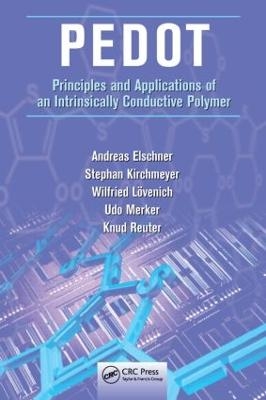
PEDOT
Crc Press Inc (Verlag)
978-1-4200-6911-2 (ISBN)
The unparalleled large-scale commercial application of poly(3,4-ethylenedioxythiophene), otherwise known as PEDOT, continues to fuel a need for literature about it that is concise, easily available, but sufficiently comprehensive. Designed to meet the requirements of readers from different areas of expertise and experience with the substance, PEDOT: Principles and Applications of an Intrinsically Conductive Polymer provides a comprehensive overview of chemical, physical, and technical information about this preeminent and most forwardly developed electrically conductive polymer.
An indispensable resource for researchers, developers, and users of PEDOT—written by the researchers who succeeded in commercializing it
A necessary response to the massive interest—as well as patents and papers—spawned by PEDOT, this handbook provides basic knowledge and explores technical applications, based on information generated by universities and academic research, as well as by industrial scientists. Available in various formulations and conductivities, this versatile PEDOT can be adapted for the needs and specific industrial applications of its different users. Although valuable information exists in handbooks on polythiophene chemistry and physics, under which PEDOT falls, until now, few if any books have focused exclusively on this important conducting polymer—certainly not one that so completely elucidates both its experimental and practical aspects.
This book:
Begins with a brief history of conducting polymers and polythiophenes
Describes the invention of PEDOT and its commercial outgrowth, PEDOT:PSS
Emphasizes key technical and commercial aspects and usage of PEDOT and how they have stimulated scientific research in a wide range of fields
Explains the chemical and physical background for PEDOT in terms of its primary use and incorporation in products including cellular phones and flat panel displays
Valuable for readers at any level of familiarity with PEDOT, this one-stop compilation of information offers specialists several unpublished results from the authors’ celebrated work, as well as often overlooked information from patents. Balancing sufficient detail and references for further study, this book is a powerful tool for anyone working in the field.
Andreas Elschner, Ph.D., was educated as a solid-state physicist at the University of Marburg (Germany) where he received his Ph.D. in 1988. Following a postdoctoral year at Stanford University (California) he joined Bayer AG in 1990, and has been with H.C. Starck since 2002. Dr. Elschner’s research focus is on organic electronics and he is responsible for testing and characterizing organic devices and conducting polymers. Stephan Kirchmeyer Ph.D., studied chemistry from 1978 to 1984 at the University of Hamburg (Germany) and at the University of Southern California in Los Angeles. Until 2001, Dr. Kirchmeyer worked as a researcher for IBM and Bayer AG. In 2002, he joined H.C. Starck GmbH and since then has held several responsible positions for H.C. Starck’s business with conductive polymers and electronic materials. Wilfried Lövenich, Ph.D., received his diploma in chemistry from the Technical University of Aachen (Germany). He then went to the University of Durham, Great Britain, to obtain his Ph.D. In 2002, Dr. Lövenich joined H.C. Starck, working as an R&D chemist on the development and pilot plant production of the conductive polymer PEDOT. Since 2009, Dr. Lövenich has been the head of the R&D group of H.C. Starck Clevios GmbH. Udo Merker, Ph.D., studied physics at the University of Bonn (Germany) from 1989 to 1994. He received his Ph.D. in 1998 for studies in molecular spectroscopy at the University of Bonn and Princeton University (New Jersey). From 1998 to 1999, Dr. Merker was a postdoctorate at the Chemistry Department of Princeton University. In 1999, he joined the corporate research division of Bayer AG to work on the development of electronic materials. From 2002 until 2008, Dr. Merker was responsible for the development of new materials and processes for electrolytic capacitors in the central R&D division of H.C. Starck GmbH. Since 2009, he has been the head of the application technology group of H.C. Starck Clevios GmbH. Knud Reuter, Ph.D., studied chemistry from 1969 to 1974 at the University of Dortmund (Germany) where he received his doctoral degree with a thesis in organometallic chemistry in 1977. In the same year, Dr. Reuter started his professional work as a member of a polymer research group at Bayer AG. Since 2000, he has worked on PEDOT chemistry, joining H.C. Starck GmbH in 2002.
The Discovery and Development of Conducting Polymers. Conductive Polymers versus Metals and Insulators. Polythiophenes: A Chance for Maximum Conductivity? A Short History of the PEDOT Invention. The Synthesis of EDOT Monomer, and Its Physical and Chemical Properties. From EDOT to PEDOT: Oxidative Polymerization and Other Routes. Counterions for PEDOT. The In Situ Polymerization of EDOT to PEDOT. PEDOT: PSS. Applications. Technical Use and Commercial Aspects. EDOT and PEDOT Derivatives with Covalently Attached Side Groups. XDOTs, EDXTs, EDOXs, and 2(5)-X(2)-EDOTs: Ring Size Variations, Heteroanalogs, and Derivatives of EDOT with Substituents at the Thiophene Ring. The Electrochemical Behavior of EDOT and PEDOT.
| Erscheint lt. Verlag | 8.11.2010 |
|---|---|
| Zusatzinfo | 23 Tables, black and white; 238 Illustrations, black and white |
| Verlagsort | Bosa Roca |
| Sprache | englisch |
| Maße | 156 x 234 mm |
| Gewicht | 657 g |
| Themenwelt | Naturwissenschaften ► Chemie ► Organische Chemie |
| Naturwissenschaften ► Chemie ► Technische Chemie | |
| Naturwissenschaften ► Physik / Astronomie ► Optik | |
| Technik ► Elektrotechnik / Energietechnik | |
| Technik ► Umwelttechnik / Biotechnologie | |
| ISBN-10 | 1-4200-6911-X / 142006911X |
| ISBN-13 | 978-1-4200-6911-2 / 9781420069112 |
| Zustand | Neuware |
| Informationen gemäß Produktsicherheitsverordnung (GPSR) | |
| Haben Sie eine Frage zum Produkt? |
aus dem Bereich


